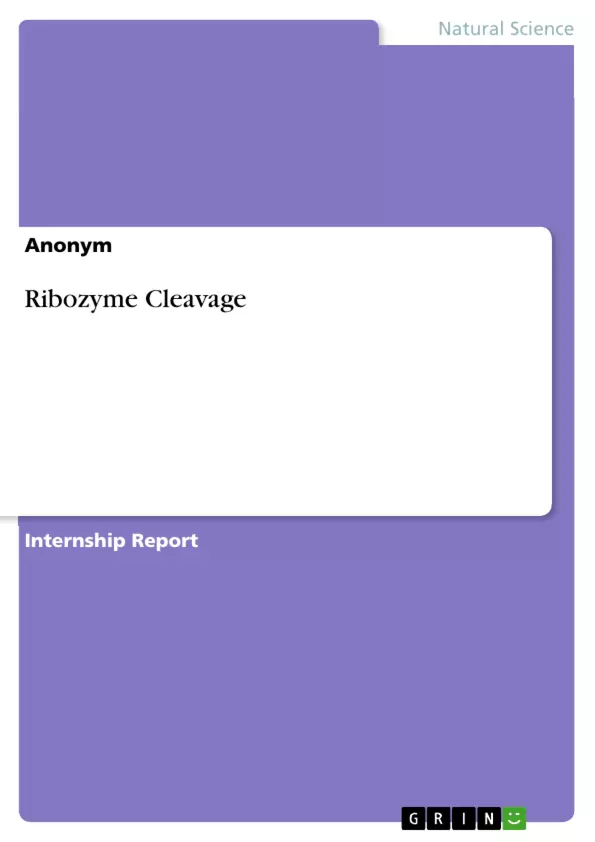The hammerhead ribozyme is a catalytic active RNA molecule that catalyzes the cleavage of RNA. This reaction is part of the in vivo self-cleavage mechanism that is observed in the rolling cycle replication mechanism of viroids.
The chemically synthesized hammerhead ribozyme that is used in this experiment forms of two RNA strands that harbor the catalytic activity and a substrate RNA strand as shown in figure 1. In the presence of MgCl2, the ribozyme adopts its active conformation and cleaves substrate strand.
In order to demonstrate the cleavage, the substrate strand is radioactively labeled with 32P at the 5’ end by T4 polynucleotide kinase.
Inhaltsverzeichnis (Table of Contents)
- Introduction
- Material and methods
- 5' tagging of the substrate strand with T4 polynucleotide kinase
- Cleavage of the substrate strand by the enyzme strand
- Results
- 5' tagging of the substrate strand with T4 polynucleotide kinase
- Cleavage of the substrate strand by the enyzme strand
- Discussion
- 5' tagging of the substrate strand with T4 polynucleotide kinase
- Cleavage of the substrate strand by the enyzme strand
Zielsetzung und Themenschwerpunkte (Objectives and Key Themes)
This text focuses on the experimental investigation of the hammerhead ribozyme, a catalytic RNA molecule that plays a crucial role in the self-cleavage mechanism observed in viroids. The main objectives are to demonstrate the cleavage of a substrate strand by the ribozyme and analyze the process of 5' tagging with T4 polynucleotide kinase. Key themes explored in the text include:- The catalytic activity of the hammerhead ribozyme
- The mechanism of RNA cleavage by the ribozyme
- The role of MgCl2 in the ribozyme's active conformation
- The use of radioactive labeling for analysis
- The experimental procedures involved in 5' tagging and cleavage
Zusammenfassung der Kapitel (Chapter Summaries)
Introduction
The introduction provides an overview of the hammerhead ribozyme, explaining its catalytic activity and its role in the self-cleavage mechanism of viroids. The text describes the experimental setup, which involves two RNA strands forming the ribozyme and a substrate RNA strand. The importance of MgCl2 in activating the ribozyme is also highlighted.Material and methods
This chapter details the experimental procedures used in the study. It focuses on two main methods:5' tagging of the substrate strand with T4 polynucleotide kinase
The process of labeling the substrate strand with radioactive 32P at the 5' end using T4 polynucleotide kinase is described. This involves the preparation of a reaction mixture, incubation, and subsequent purification steps to isolate the labeled substrate.Cleavage of the substrate strand by the enyzme strand
The chapter describes the setup for the cleavage reaction, including the preparation of the HH solution containing the ribozyme strands and the labeled substrate. The incubation conditions and the use of a control sample are also explained.Results
This section presents the results obtained from the experiments described in the previous chapter. It includes data on the 5' tagging of the substrate strand and the cleavage reaction, potentially showing the success of the labeling and the effectiveness of the ribozyme in cleaving the substrate strand.Discussion
The discussion chapter analyzes the experimental findings, interpreting the results and drawing conclusions about the hammerhead ribozyme's function. It likely discusses the efficiency of the 5' tagging process, the effectiveness of the ribozyme in cleaving the substrate, and potential implications for understanding the ribozyme's role in biological processes.Schlüsselwörter (Keywords)
The key terms and concepts explored in this text include: hammerhead ribozyme, RNA cleavage, catalytic activity, self-cleavage mechanism, viroids, 5' tagging, T4 polynucleotide kinase, radioactive labeling, MgCl2, substrate strand, enzyme strand, experimental procedures, and data analysis.- Arbeit zitieren
- Anonym (Autor:in), 2014, Ribozyme Cleavage, München, GRIN Verlag, https://www.hausarbeiten.de/document/282480


